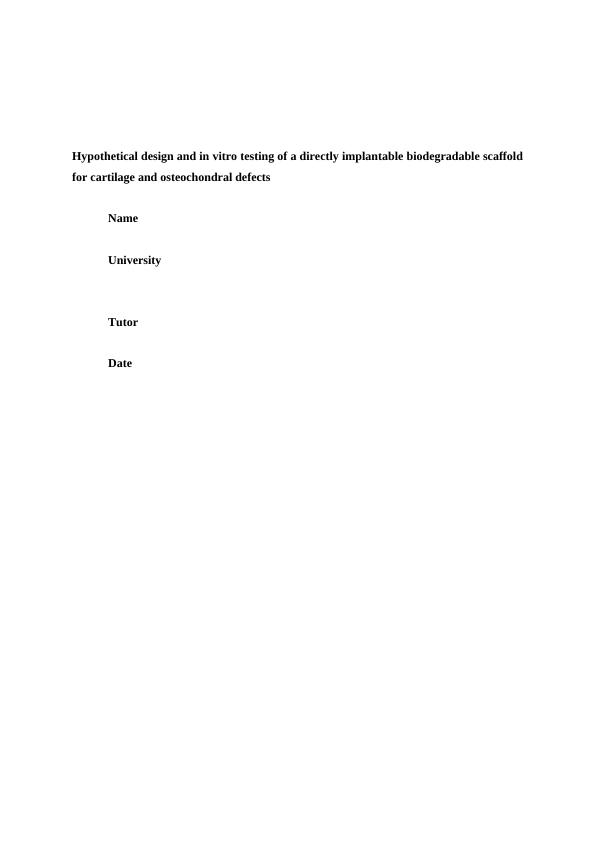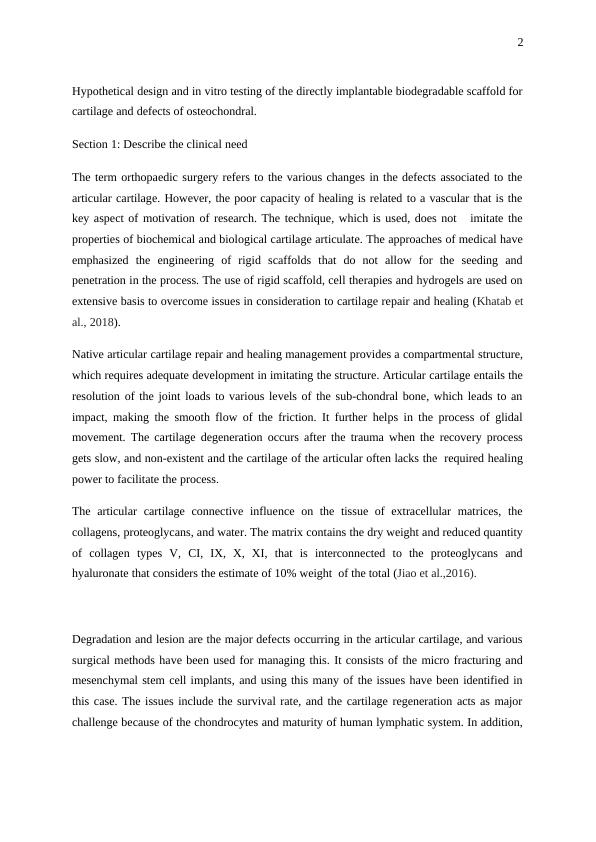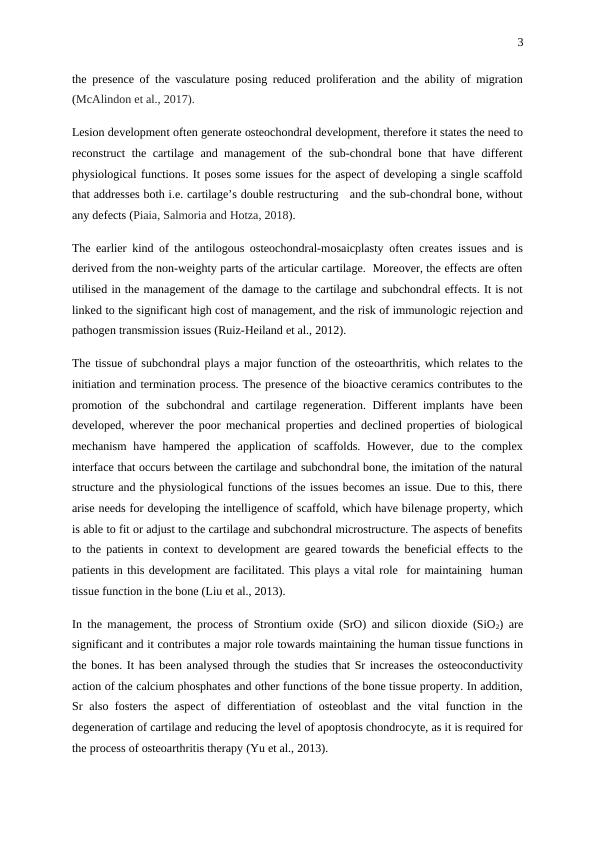Hypothetical Design and In Vitro Testing of a Directly Implantable Biodegradable Scaffold for Cartilage and Osteochondral Defects
Added on 2023-01-17
9 Pages3074 Words82 Views
Hypothetical design and in vitro testing of a directly implantable biodegradable scaffold
for cartilage and osteochondral defects
Name
University
Tutor
Date
for cartilage and osteochondral defects
Name
University
Tutor
Date

2
Hypothetical design and in vitro testing of the directly implantable biodegradable scaffold for
cartilage and defects of osteochondral.
Section 1: Describe the clinical need
The term orthopaedic surgery refers to the various changes in the defects associated to the
articular cartilage. However, the poor capacity of healing is related to a vascular that is the
key aspect of motivation of research. The technique, which is used, does not imitate the
properties of biochemical and biological cartilage articulate. The approaches of medical have
emphasized the engineering of rigid scaffolds that do not allow for the seeding and
penetration in the process. The use of rigid scaffold, cell therapies and hydrogels are used on
extensive basis to overcome issues in consideration to cartilage repair and healing (Khatab et
al., 2018).
Native articular cartilage repair and healing management provides a compartmental structure,
which requires adequate development in imitating the structure. Articular cartilage entails the
resolution of the joint loads to various levels of the sub-chondral bone, which leads to an
impact, making the smooth flow of the friction. It further helps in the process of glidal
movement. The cartilage degeneration occurs after the trauma when the recovery process
gets slow, and non-existent and the cartilage of the articular often lacks the required healing
power to facilitate the process.
The articular cartilage connective influence on the tissue of extracellular matrices, the
collagens, proteoglycans, and water. The matrix contains the dry weight and reduced quantity
of collagen types V, CI, IX, X, XI, that is interconnected to the proteoglycans and
hyaluronate that considers the estimate of 10% weight of the total (Jiao et al.,2016).
Degradation and lesion are the major defects occurring in the articular cartilage, and various
surgical methods have been used for managing this. It consists of the micro fracturing and
mesenchymal stem cell implants, and using this many of the issues have been identified in
this case. The issues include the survival rate, and the cartilage regeneration acts as major
challenge because of the chondrocytes and maturity of human lymphatic system. In addition,
Hypothetical design and in vitro testing of the directly implantable biodegradable scaffold for
cartilage and defects of osteochondral.
Section 1: Describe the clinical need
The term orthopaedic surgery refers to the various changes in the defects associated to the
articular cartilage. However, the poor capacity of healing is related to a vascular that is the
key aspect of motivation of research. The technique, which is used, does not imitate the
properties of biochemical and biological cartilage articulate. The approaches of medical have
emphasized the engineering of rigid scaffolds that do not allow for the seeding and
penetration in the process. The use of rigid scaffold, cell therapies and hydrogels are used on
extensive basis to overcome issues in consideration to cartilage repair and healing (Khatab et
al., 2018).
Native articular cartilage repair and healing management provides a compartmental structure,
which requires adequate development in imitating the structure. Articular cartilage entails the
resolution of the joint loads to various levels of the sub-chondral bone, which leads to an
impact, making the smooth flow of the friction. It further helps in the process of glidal
movement. The cartilage degeneration occurs after the trauma when the recovery process
gets slow, and non-existent and the cartilage of the articular often lacks the required healing
power to facilitate the process.
The articular cartilage connective influence on the tissue of extracellular matrices, the
collagens, proteoglycans, and water. The matrix contains the dry weight and reduced quantity
of collagen types V, CI, IX, X, XI, that is interconnected to the proteoglycans and
hyaluronate that considers the estimate of 10% weight of the total (Jiao et al.,2016).
Degradation and lesion are the major defects occurring in the articular cartilage, and various
surgical methods have been used for managing this. It consists of the micro fracturing and
mesenchymal stem cell implants, and using this many of the issues have been identified in
this case. The issues include the survival rate, and the cartilage regeneration acts as major
challenge because of the chondrocytes and maturity of human lymphatic system. In addition,

3
the presence of the vasculature posing reduced proliferation and the ability of migration
(McAlindon et al., 2017).
Lesion development often generate osteochondral development, therefore it states the need to
reconstruct the cartilage and management of the sub-chondral bone that have different
physiological functions. It poses some issues for the aspect of developing a single scaffold
that addresses both i.e. cartilage’s double restructuring and the sub-chondral bone, without
any defects (Piaia, Salmoria and Hotza, 2018).
The earlier kind of the antilogous osteochondral-mosaicplasty often creates issues and is
derived from the non-weighty parts of the articular cartilage. Moreover, the effects are often
utilised in the management of the damage to the cartilage and subchondral effects. It is not
linked to the significant high cost of management, and the risk of immunologic rejection and
pathogen transmission issues (Ruiz-Heiland et al., 2012).
The tissue of subchondral plays a major function of the osteoarthritis, which relates to the
initiation and termination process. The presence of the bioactive ceramics contributes to the
promotion of the subchondral and cartilage regeneration. Different implants have been
developed, wherever the poor mechanical properties and declined properties of biological
mechanism have hampered the application of scaffolds. However, due to the complex
interface that occurs between the cartilage and subchondral bone, the imitation of the natural
structure and the physiological functions of the issues becomes an issue. Due to this, there
arise needs for developing the intelligence of scaffold, which have bilenage property, which
is able to fit or adjust to the cartilage and subchondral microstructure. The aspects of benefits
to the patients in context to development are geared towards the beneficial effects to the
patients in this development are facilitated. This plays a vital role for maintaining human
tissue function in the bone (Liu et al., 2013).
In the management, the process of Strontium oxide (SrO) and silicon dioxide (SiO2) are
significant and it contributes a major role towards maintaining the human tissue functions in
the bones. It has been analysed through the studies that Sr increases the osteoconductivity
action of the calcium phosphates and other functions of the bone tissue property. In addition,
Sr also fosters the aspect of differentiation of osteoblast and the vital function in the
degeneration of cartilage and reducing the level of apoptosis chondrocyte, as it is required for
the process of osteoarthritis therapy (Yu et al., 2013).
the presence of the vasculature posing reduced proliferation and the ability of migration
(McAlindon et al., 2017).
Lesion development often generate osteochondral development, therefore it states the need to
reconstruct the cartilage and management of the sub-chondral bone that have different
physiological functions. It poses some issues for the aspect of developing a single scaffold
that addresses both i.e. cartilage’s double restructuring and the sub-chondral bone, without
any defects (Piaia, Salmoria and Hotza, 2018).
The earlier kind of the antilogous osteochondral-mosaicplasty often creates issues and is
derived from the non-weighty parts of the articular cartilage. Moreover, the effects are often
utilised in the management of the damage to the cartilage and subchondral effects. It is not
linked to the significant high cost of management, and the risk of immunologic rejection and
pathogen transmission issues (Ruiz-Heiland et al., 2012).
The tissue of subchondral plays a major function of the osteoarthritis, which relates to the
initiation and termination process. The presence of the bioactive ceramics contributes to the
promotion of the subchondral and cartilage regeneration. Different implants have been
developed, wherever the poor mechanical properties and declined properties of biological
mechanism have hampered the application of scaffolds. However, due to the complex
interface that occurs between the cartilage and subchondral bone, the imitation of the natural
structure and the physiological functions of the issues becomes an issue. Due to this, there
arise needs for developing the intelligence of scaffold, which have bilenage property, which
is able to fit or adjust to the cartilage and subchondral microstructure. The aspects of benefits
to the patients in context to development are geared towards the beneficial effects to the
patients in this development are facilitated. This plays a vital role for maintaining human
tissue function in the bone (Liu et al., 2013).
In the management, the process of Strontium oxide (SrO) and silicon dioxide (SiO2) are
significant and it contributes a major role towards maintaining the human tissue functions in
the bones. It has been analysed through the studies that Sr increases the osteoconductivity
action of the calcium phosphates and other functions of the bone tissue property. In addition,
Sr also fosters the aspect of differentiation of osteoblast and the vital function in the
degeneration of cartilage and reducing the level of apoptosis chondrocyte, as it is required for
the process of osteoarthritis therapy (Yu et al., 2013).

End of preview
Want to access all the pages? Upload your documents or become a member.
Related Documents
Hypothetical Design and In Vitro Testing of a Biodegradable Scaffold for Cartilage and Osteochondral Defectslg...
|9
|2847
|50
